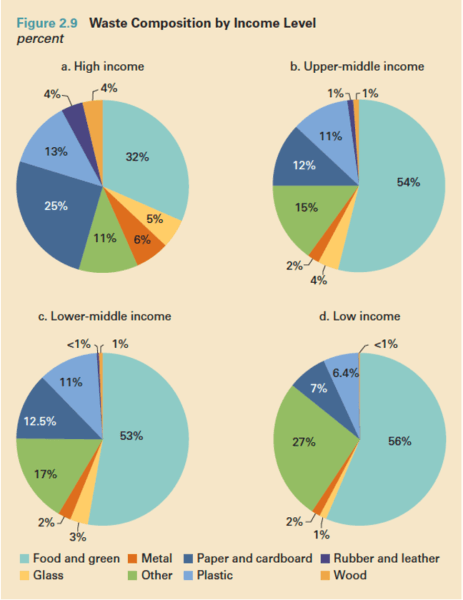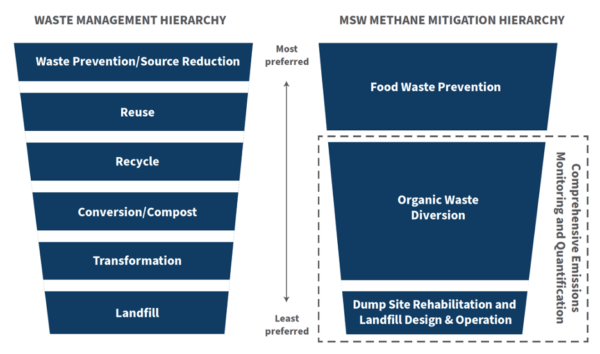
How our trash contributes to climate change — and what we can do about it
The climate impacts of our trash are becoming harder to ignore. The waste sector is one of three key methane emitting sectors — following agriculture and oil and gas — and is responsible for about 20% of human-driven methane emissions globally. In the short-term, methane is more than 80 times more potent than carbon dioxide as a climate pollutant and accounts for nearly half of the 1 degree Celsius of warming we’ve experienced to date. Quickly and significantly reducing methane pollution is one of the most important opportunities we have to slow the pace of global warming in the next two decades, a critical time period for avoiding potentially irreversible climate tipping points. Furthermore, methane mitigation is critical to keeping our long-term Paris Agreement goals within reach.
How does waste generate methane emissions?
Waste sector methane emissions stem from the breakdown of organic waste — food and yard waste, as well as paper, cardboard, and wood — in anaerobic (i.e., oxygen free) environments. When broken down by source, the waste sector is split into emissions from solid waste and wastewater. Solid waste emissions from landfills and dumps represent the majority of methane emissions from the sector. Here, organics decay slowly over decades, releasing what is commonly known as landfill gas (LFG), a combination of methane and carbon dioxide.
The amount of methane produced by a landfill is primarily based on the amount of organics in the waste stream. Globally, organic waste makes up about 65% of waste generated, with food and green waste as the largest share. But waste composition can vary widely between countries, generally depending on income level. In lower-income countries, food and green waste represent a much larger share of the waste stream. As countries develop, this percentage decreases as paper, plastics, and glass use become more common.

Global waste is growing
The World Bank estimates that by 2050 we will be generating 3.88 billion tonnes of waste each year, a 73% increase from 2020. As waste generation is tightly tied to population growth and economic development, the largest increases are projected to occur in Sub-Saharan Africa and South Asia. And in much of the world, waste management practices and systems are poor or non-existent, which will lead to increasing emission of short-lived climate pollutants. In fact, methane emissions from waste are expected to increase by 13 megatons per year over the next decade alone.

Proven solutions are available to reduce methane from the waste sector
Fortunately, we have cost-effective solutions to reduce emissions from the waste sector today, with up to 60% of mitigation measures having low or negative costs. You may have seen the waste hierarchy before, or heard the phrase “reduce, reuse, recycle.” These phrases are used to demonstrate waste management options in order of environmental preference, and stress that landfilling and disposal are a last resort option. We can use a slightly modified hierarchy to highlight methane mitigation strategies for solid waste:

- Food Waste Prevention involves reducing the amount of food that we consider to be “waste,” and diverting it for use. In practice this can mean promoting “ugly” produce programs, revising food best-by and use-by dates so good food is not thrown away, linking large producers of food waste to food banks, and raising awareness of the importance of waste prevention, among a variety of other solutions. In addition to keeping usable food out of landfills, these actions help increase food security and lower upstream GHG emissions from food production. The United Nations Sustainable Development Goals include a target to halve per capita global food waste at the retail and consumer level and reduce food loss during production by 2030.
For example, São Paulo’s Municipal Program to Combat Waste and Loss of Food collects food from markets that is good for consumption, but would otherwise become waste, and redistributes it to improve food security in the city. In 2019, the program collected 270 tons of food and distributed it to over 120,000 residents. The program was combined with São Paulo’s Sustainable Fairs and Gardens Program which diverts the remaining organic market waste to composting facilities. Over 9,000 tons of organic waste have been diverted from landfills through these partnerships.
- Organic Waste Diversion is the next step in keeping this waste out of landfills. Organic waste can be separated at the source by waste generators (i.e., keeping a separate bin for food waste in your kitchen) or at a facility designed for separating mixed municipal waste. Source separation by waste generators is the technically preferred option as it reduces contamination — bits of plastic or glass winding up in the waste — which is important for most treatment options. There are often other cultural and socioeconomic considerations that impact organic waste diversion program design. The two most common organic waste treatment options are composting and anaerobic digestion.
South Korea has one of the most efficient organic waste diversion programs in the world and recycles 95% of its food waste. Most Korean meals are accompanied by banchan — side dishes — that are rarely fully eaten and contribute to large quantities of food waste in the country. Korea has multiple laws to target food waste, including a 2005 ban on landfilling of food and a 2014 weight-based food collection and disposal program. Residents are required to either buy biodegradable bags for their food waste to offset the cost of recycling and treatment, or in urban areas they bring waste to communal bins equipped with a radio frequency identification (RFID) chip reader and scale that weighs the waste and charges accordingly.
- Dump Site Rehabilitation and Landfill Design & Operation is critical to capturing methane generated from organics that are not diverted, as well as waste already in landfills — waste disposal facilities designed to have environmental and human health control systems — and dumps, facilities which have little to no controls in place. Open dumps, present in much of the developing world, pose human and environmental health and safety risks. Though up-front costs are high, dumps can be redesigned to include environmental control systems, including covers that oxidize methane as it is released and LFG capture. Existing sanitary landfills with LFG capture systems can focus on maximizing collection and use of the generated gas.
Different waste solutions work in different regional and economic contexts
There are no one-size-fits-all solutions for improved waste management. However, examples of good policies and best practices to promote enhanced waste management and methane mitigation can be found in every region of the world. Examples of policies include:
- India’s Solid Waste Management Rules, 2016 require that waste generators segregate waste into biodegradable, non-biodegradable, and domestic hazardous fractions. Biodegradable waste is then processed, treated, and disposed of through composting or bio-methanation.
- Chile’s National Organic Waste Strategy sets a target to recover 66% of municipal organic waste by 2040 through source separation. The strategy promotes food waste prevention through education, better governance structures, and improved technology. The strategy will be considered successful if, by 2040, Chilean citizens avoid food waste, organic waste generation, and separate unavoidable waste at source.
- EU Landfill Directive and Waste Framework Directive work in tandem to reduce the total amount of waste that is landfilled, including bio-waste, through the encouragement of source separation and recycling of bio-waste. It also requires LFG collection and use (or flare) from landfills. The 2023 revision of the Waste Framework Directive is also considering a food waste reduction target to be implemented by 2030.
- South Korea’s suite of waste management rules create a system that focuses on waste reduction, recycling, and energy recovery. A volume-based waste fee for households has led to a 61% recycling rate, and a ban on direct landfilling of food waste and weight-based collection system is encouraging food waste reduction. Because of space constraints and pushback from residents, the 1995 Act on Promotion of Installation of Waste Disposal Facilities and Support for Adjacent Areas was passed to create support funds and communication channels with residents to plan for waste management projects over a set size.
- Oregon’s Landfill Gas Emissions Rule tightens permitting, data collection, and LFG requirements in the state. The rule creates a tiered system where active and closed landfills with: 1) greater than 200,000 tons of waste in place, 2) a calculated methane generation rate greater than 664 metric tons per year, and 3) measured concentrations of methane of 200 parts per million by volume or greater must install a gas collection system.
In designing these policies, each country must account for the primary goals of the waste management system, cultural considerations, budgetary constraints, and other major challenges they face. In regard to organic waste, policies must be designed in such a way as to avoid unhelpful incentives — like providing large incentives for LFG systems that disincentivize prevention and diversion programs. Waste management is also primarily implemented at the municipal level, and gaps between national ambition and local capacity are often a limitation to improving management practices.
CATF is working to help countries around the world prioritize the waste sector in methane mitigation plans and goals, a necessary step for many countries to meet Global Methane Pledge ambitions. We advocate for regulations to tighten controls on landfill methane emissions and policies to improve organic waste management, and provide capacity building support to highlight best practices for waste methane mitigation. We also support financial instruments and other solutions that can be utilized to scale-up mitigation and drastically reduce methane from solid waste.



